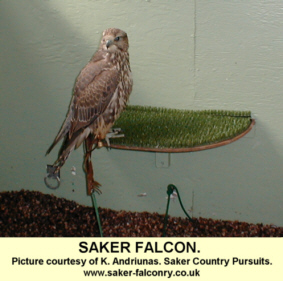
SAKER FALCON.
Falco cherrug 
‘The Squires Falcon’
IDENTIFICATION. Saker plumage varies a great deal. Generally the back and tops of the wings are brown with the chest being a mixture of browns, creams and whites. In some birds the whites and creams take over the plumage giving the falcon the appearance of a large Lugger.
The head has a darker brown moustache and eye brow line. The feet and cere turn from the blue/grey of the juvenile to the yellow of the adult in the second year.
DISTRIBUTION. Eastern Europe, Russia and Turkey. Migrating to the Middle East, China, India, Pakistan and the Mediterranean in winter. Preferred habitats are mountainous areas, with wide open spaces such as grassland, savannah and dessert.
FOOD. Generally small to medium sized rodents and birds to the size of bustards. Supplemented with reptiles and insects.
BREEDING. March-June. 2- 5 eggs laid in Kite, Stork or Eagle nest.
SIZE. 45-50cm (18-20in)
WEIGHT. 650g-1080g (1lb 7oz-2lb 6oz)
WINGSPAN. 104-129 cm (41-51in)
CALL. kek kek kek
FALCONRY.
A strong flier, even in fairly high winds, the Saker Falcon has a mixed reputation in the UK. Capable of taking such quarry as Pheasants, Gulls and corvids the draw backs lie in the Sakers twice yearly urge to mygrate. Food control has to be watched as Sakers can be greedy.
Falconry marks
![]()
![]()
![]()
![]()